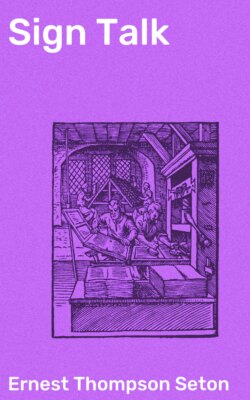Читать книгу Sign Talk - Ernest Thompson Seton - Страница 12
На сайте Литреса книга снята с продажи.
A COMPARISON OF THE TWO CODES
ОглавлениеTable of Contents
A comparison of the Deaf and Indian Codes seems to emphasize the superiority of the Indian. The Deaf was intended to convey, word by word, a vocal language; it assumes that you know the other man’s speech, and can spell. Whereas, the Indian was invented to over-ride linguistic barriers and, knowing nothing of spelling, deals only with ideas.
The next great advantage of Indian style is its picturesqueness. The two systems can be illustrated and fairly compared by the signs for the months.
First the Deaf:
January—Sign for Month, then J, N, and R, that is 4 signs.
June—Sign for Month, then J and N, that is 3 signs.
July—Sign for Month, then J and L, again 3 signs.
Whereas the Indian calls January the Snow Moon, thus moon or “Horns in the sky” and snow, that is two signs. June is Rose Moon i.e., horns or Crescent in the sky and rose (the right hand plucking an imaginary petal from each finger tip of the left). July is the Thunder Moon, i.e., horns in the sky, then the right index darted downward in a quick zigzag to imitate lightning. All need but two signs each.
The first involving a certain amount of spelling is limited to those who can read, and who use that word. The second, touching nothing but the idea, is widely acceptable, much shorter, and visible much farther off. It was apparently developed for the safe distance beyond arrow range.
Again the Indian method is strong in its dignity. The deaf often spoil their sign-talk by grimacing, the Indian never does so. One may occasionally help the idea by facial expression, but it should be used with great reserve, as there is nothing more unlovely or likely to harm the study of the Sign Language than the excessive grimacing that one sometimes sees in an uneducated deaf-mute. The Indian sign-talker’s face is calm and little changed, his head is moved in graceful sweeps, and never jerked unless to express some jerky action. His communication is indeed a study in beautiful, dignified gesture. There is not an Indian sign in this book that depends on facial expression for its usefulness, and there are but few that involve the face in any way.
Last year (1910) my friend Hamlin Garland met a party of moving picture men returning from a business tour among the Indians. He asked, “Did you get two old chiefs talking together in the Sign Language?” They said “No, hadn’t heard of it.”
“Then,” he replied, “you have missed one of the most graceful and rewarding chances for your special art that the western country affords.”
They were so much impressed with his description that they went back. Having brought together two chiefs of diverse speech they got results on their films which amply justified their time and trouble.
Finally a large number of the signs used by the deaf are conventional and arbitrarily fixed, dating back about 100 years, whereas each Indian sign is the slow evolutionary product of ages, with its roots deep in human nature. It is never arbitrary, but so logical and so reasonable that it is easily and quickly learned.
Every interested person, therefore, must regret profoundly that the teachers of the deaf should have gone out of their way to fabricate an unnatural, localized code, when there was awaiting them ready-made, and already established, a system founded on universal human nature, old as the hills, full of the charms of grace and poetry, and so logical that any one of any race can learn it in a tithe of the time required for the acquisition of the merest smattering of a spoken language, and the adoption of which would at once have greatly lessened the handicap of the deaf. One can only suppose that the founders of the code were unaware of the other’s existence.
Undoubtedly actual service has done much to reform and redeem the Deaf Code and make it more nearly a true Sign Language, but one cannot help wishing that their teachers would take the inevitable step at once and adopt the natural system.
Thus we have logic with us as well as the opinion of ethnologic students in giving preference to the Indian System. While in the extent of usage honors are about even, I am credibly assured that about 100,000 people are daily using the Deaf Code and an equal number using the Indian.
It is my belief that an available popular Manual will soon establish the latter as the universal code and result in its further and full development.
